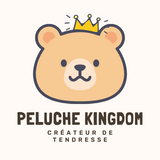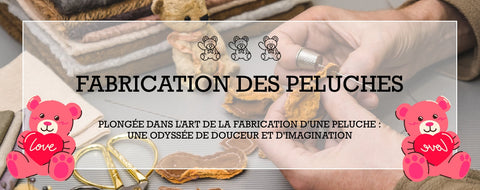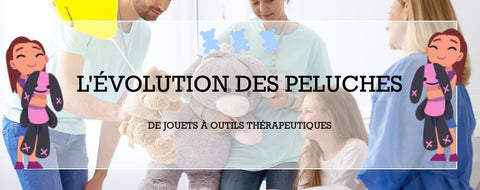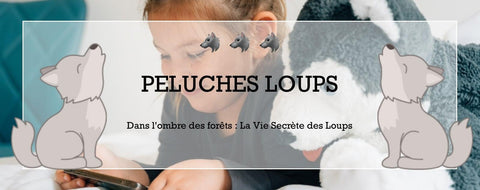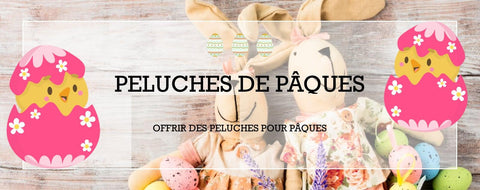
Who invented stuffed animals?
of reading - words

The legendary brown “teddy bear” is the precursor of the soft toys so beloved by children, but also by adults. Many enthusiasts of this educational toy still collect them after childhood. Originally, this toy was mainly given at Christmas to children who told it all their secrets, their little moments of sadness, but who also shared their joy.
Several decades after its invention, the teddy bear still holds a special place in the daily lives of little ones. The variants of the little brown bear are very numerous today and it has been "modernized" over the years. We owe the invention of this iconic object to two historical figures, Richard Steiff and Morris Michtom . Focus on the history of stuffed animals from their invention to the present day.
1. When were soft toys invented ?
Three protagonists have made the teddy bear a coveted, adored cuddly toy that never gets old. Two men and a woman looked into the playful and entertaining side of this plush toy, the first on the market at the start of the 20th century.
A. Margarete Steiff: who is she ?
The story begins with German seamstress Margarete Steiff. The founder of the Steiff brand who continues to make children's eyes shine at the sight of this timeless brown bear .
Margarete was born in Stuttgart in the 1840s. At a very young age, she was already very skilled at making small felt animals that had two destinies. That of a toy and a needle cushion for her seamstress friends and her acquaintances who then began to jostle at the gate. This very remarkable personality, however, had great physical difficulties. She then strived to “sell” dreams to children through her art and her know-how, considered almost as a gift, she excelled so much. His first piece, the one that contributed to his success, was a pincushion in the shape of an elephant. It was a phenomenal success.
His creations and especially his story have remained engraved in memories for nearly 150 years. Margarete Steiff always sought excellence. She never stopped working to produce ever better quality articles. His exponential success is reflected in his personal motto: “He who believes in himself is free” .
B. Richard Steiff: the little nephew who will grow up :
In the incredible history of the Steiff company there is Richard Steiff. Another big head of the company who contributed greatly to its growing fame. 4 years after the company was officially founded in 1897, Margarete Steiff was already participating in the Leipzig Toy Fair. A famous exhibition dedicated to model making, manufacturing and the creation of original but fun toys and games. It was also a trade fair also dedicated to publicizing new trends in the creators of authentic objects, accessories and toys.
1897 also marks the arrival of Richard Steiff. This is how he joined his aunt's business after completing his studies at the art school in the German city of Stuttgart. To get his career in the family business off to a good start, he was assigned to the Steiff company stand at the Leipzig trade fair. He represented it well.
Richard was his aunt Margarete's little protégé. From his first years in art school, his aunt was already pushing him to improve in his ambition to become a famous designer. After Margarete, Richard was the person destined to become No. 2 in the Steiff company. Then he had the idea of creating the teddy bear which would later become the icon of children's games around the world.

Richard was a real bear enthusiast. This passion has earned him his fame in the world of designing soft toys that children like. To make his prototype, Richard studied the behavior of real bears. So he then designed numerous drawings and sketches in order to determine the lines, shapes and colors of the animal. The Stuttgart Zoo was his inspiration. He observed his favorite animals there several times a week.
Then he was also among the audiences of circuses and traveling wild animal shows. At the end of the 19th century, Richard was finally able to realize his project. He then made a large number of teddy bears on four legs among others . Some models were designed with cast iron wheels. To be used during games for children who liked to shoot toys. Richard also made teddy bears that stood upright on their hind legs . This mode of design was chosen to allow the toy to move. Like real live animals.
To give life to his little animals like no other, he set about making teddy bears with articulated limbs in 1902. Children were his target “customers”. It was then the first toy of its kind ever made by any toy manufacturer. This prototype was to become the favorite toy of children who need constant companionship and the reassurance of a presence. This first teddy bear had a code name: PB Bär 55 . It was then presented for the first time at the Leipzig fair in 1903.
C. Richard Steiff and the Leipzig Fair: the winning combination :
1903 was therefore a pivotal year for Margarete's little nephew, who was to grow up. It was during the Leipzig Toy Fair that the man became known to the general public. Especially by fans of the little brown bear , which had just been released this year.
Richard Steiff caught the eye of the greatest, notably George Borgfeldt. Straight from New York, looking for a toy like no other. But also in search of the manufacturer whose authenticity was in spades. George Borgfeldt was, however, a man who was very demanding in his choices. When he visited the Steiff family stand, he found a match for his feet. However, he then ordered 3,000 copies of the brown bear from the company to “try”.
There then begins the long journey of the original bear. The stuffed animal that everyone still loves today. The little brown bear translates gentleness, trust and confidence for all children in the world. This brown bear is still today synonymous with dreams, indelible memories and magic for many children and even adults.
D. Morris Michtom, the “heir” :
Morris Michtom (1870 – 1938) was the man behind the Teddy Bear . At this time the dual paternity of the teddy bear came back to the forefront. Morris Michtom was a Russian man who knew how to draw inspiration from a landmark event to propel his creation. Subsequently he will become the second legend after the brown bear designed by the Steiff family.
An anecdote then propelled him to the forefront. Morris Michtom took advantage of an event that happened to the President of the USA at the time, Theodore Roosevelt. Legend has it that the head of state participated in a bear hunt in the state of Mississippi. And that he would have returned empty-handed after hours of venturing into the forest. To fool the eyes of detractors, his associates and other right-hand men suggested that he install a teddy bear on a tree. This was to make it appear that the president had won in his quest for the “ideal prey.” The next day, however, this situation was widely publicized through one of the most famous early dailies of the time. The Washington Post then published this “legend” on the front page of its newspaper the following morning. This first page was indeed illustrated by a renowned designer who succeeded in depicting the icon of the moment: the little brown bear . This is where Morris Michtom's idea of creating the little brown bear came from. This time with the one and only Teddy Bear. Teddy is in fact referring to President Roosevelt, that was absolutely his nickname.

2. The Teddy Bear: towards decline ?
The great wars disrupted the teddy bear trade. But also its manufacturing. Products from Germany were then prohibited from exporting, but the brown bear from the Steiff company mainly came from there. Then begins the decline of the main supplier of this toy so adored by the public, young and old.
New firms then took advantage of this to grow their business. They did not skimp on their imagination to produce a plush not exactly similar to the original model. The international market is such that it was necessary to demonstrate greater creativity to bring to light a toy, the manufacturing monopoly of which was exclusively attributed to a nation and a family business. It was then time for them to find another way to stand out. These new industries then relied on the diversity of materials to divert consumers' attention to the authentic brown bear. The one made by the Steiff family. They then used different fabrics and other affordable accessories to produce the same toy with the same pout and the same softness a priori as the original model.
It was then necessary to find a way to put on the market variants as soft and light as their predecessor. Kapok was a highly coveted material at the time. It was as soft as wool, which Margarete had drawn inspiration from for her many creations since she was very young. Kapok was an alternative to wood straw which became inaccessible to ordinary people at the time of the great wars.
Artificial materials were also on the rise. Unnatural self-plush was then valiantly exploited to satisfy consumers. It was then woven from cellulose fibers of woody plants . These materials somewhat changed the appearance of the little brown bear which began to change color depending on the manufacturers and the materials made available to them in a time as difficult as a world war. Having been unable to reproduce the characteristic brown color of the real teddy bear , manufacturers – since they have become one – have completely focused on different colors. There, the brown bear becomes the pink teddy bear , blue teddy bear, or white teddy bear , etc. They also had an important particularity: their eyes were made of glass.

The 1960s also marked a new turning point in the history of plush toys . Asian competitors entered the market unexpectedly. This great pressure was beginning to weigh on the international market. Since the “original” bears have gradually deserted the market of toys and educational games. Labor was scarce in Europe because of the war and other difficulties of life in difficult times. China was gradually beginning to show its peak in different areas of industry. Particularly in the toy sector and particularly soft toys . Labor was plentiful in the Middle Kingdom and the country was beginning to become a major world power, not only in the field of toys, etc., but also in other export activities aimed at satisfying a increasing demand in relation to supply.
The Chinese had also invested heavily in machines that could do almost everything in place of a human workforce. Especially tools for stuffing teddy bears with air helped them a lot. Mechanical fabric and upholstery cutters also gradually flooded the market for toys, their manufacturing and design. The artistic side of the brown bear was then supplanted by the capacity of Asian countries to invent alternatives that were less and less expensive and more and more practical and suitable for all uses. From the 1970s, traditional bears were gradually supplanted by other animal representations that were no less cute and which inspired confidence in children. The most fashionable plush models always represent animals. But not just bears. Then began the meteoric rise of the octopus plush or the reversible plush and many others.

